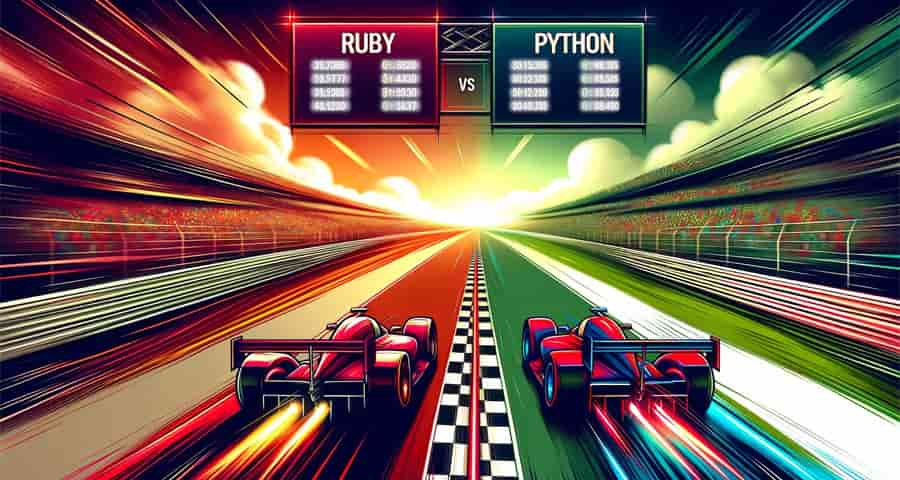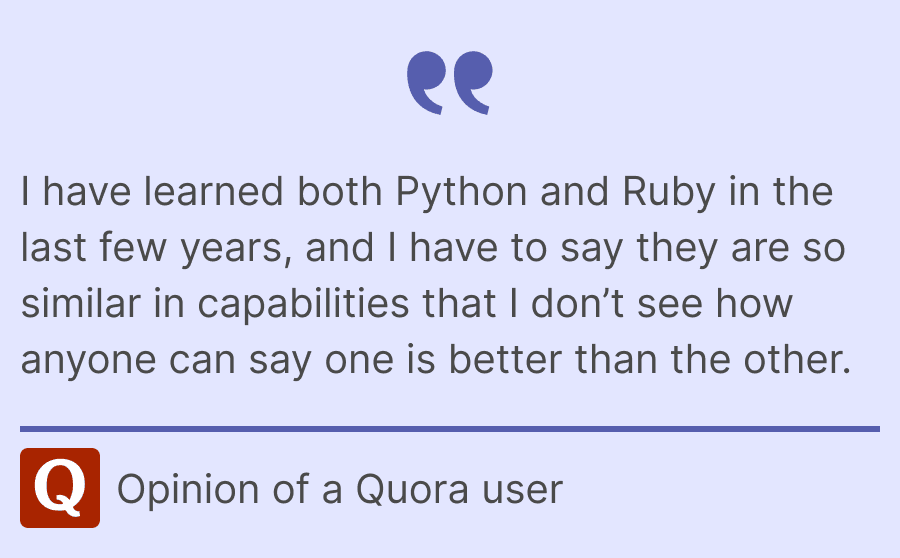Ruby vs. Python: Which Language Is Right for Your Project?
Topic: Tech

March 7, 2024
Python and Ruby stand out as two prominent programming languages, each with its own unique strengths and weaknesses. According to Statista's 2023 ranking of the most popular programming languages, Python holds the third position, with 49.28% of respondents stating they use it. In contrast, Ruby ranks 16th on the list, with 6.23% of respondents indicating its usage.
With so many projects powered by these app development languages, how do software teams choose between them? This article will compare Ruby and Python across key factors to consider when deciding which language will best meet your app development needs. We'll analyze the benefits of each language, how they compare for web and mobile apps, future trends, and considerations when hiring Ruby versus Python developers. The goal is to provide product owners, entrepreneurs, and technical leaders with a comprehensive guide to selecting the best language for their upcoming software projects.
What is Ruby?
Ruby is a dynamic, open source, object-oriented scripting language known for its simplicity and programmer happiness. Created by Yukihiro "Matz" Matsumoto, Ruby emphasizes code readability and productivity.
Some key features of Ruby include:
- Object-oriented programming - Ruby utilizes classes, methods, objects, and variables to structure and organize code. This facilitates code reuse.
- Dynamic typing - The type of variables is checked at runtime, not during compilation. This gives developers flexibility.
- Interpreted execution - Ruby code is executed line-by-line by an interpreter, allowing for real-time evaluation.
Ruby is a general-purpose language used to build web applications, games, data analysis, machine learning, and more. Popular Ruby web frameworks include Ruby on Rails and Sinatra.
What is Python?
Python is an interpreted, high-level programming language known for its clear syntax, readability, and large standard library. Created by Guido van Rossum, Python enables rapid development through the use of significant white space, rather than braces or keywords.
Key features of Python include:
- Interpreted execution - Python code is executed line-by-line by an interpreter, facilitating real-time evaluation.
- Object-oriented programming - Python utilizes classes, methods, encapsulation, and polymorphism.
- Extensive libraries - Python has a vast collection of libraries and frameworks for tasks like data analysis, machine learning, and web development. Popular examples include NumPy, Pandas, Django and Scikit-learn.
Python is a general-purpose language used for web development, data science, AI, IoT, and more. Its high-level nature makes it easy to read, write, and maintain.

Benefits of Ruby and Python for App Development
Both Ruby and Python provide advantages for startups and companies looking to build web or mobile applications.
Ruby benefits for app development include:
- Rapid development with Ruby on Rails framework
- Code readability and elegance
- Strong community and ecosystem
- Enjoyable coding experience that increases productivity
Python benefits for app development include:
- Easy to learn syntax and readability
- Vast libraries for data analysis, machine learning, and AI
- Scalability for complex applications
- Community support and abundant resources
Ruby's focus on programmer happiness makes it a joy to work with. Python's simple syntax enables developers to become productive quickly. Both languages are excellent choices for minimum viable products (MVPs) and prototypes.
Comparisons: Ruby vs. Python
So how do Ruby and Python stack up against each other for app development? Here's an overview of how they compare.
| Comparison Factor | Ruby | Python |
|---|---|---|
| Web Development | Ideal for building web apps thanks to Ruby on Rails, which enables rapid prototyping. Rails utilizes conventions, eliminating the need to rewrite boilerplate code. | Excel at web development with frameworks like Django, Flask, and Pyramid. The language's readability makes Python web apps easy to maintain. |
| Mobile App Development | For native mobile apps, can be used on platforms like iOS, Android, and Windows Mobile. Ruby offers RubyMotion. For cross-platform mobile apps, leverages Rhodes. | Has a broader offering of mature mobile development frameworks like Kivy, Flask, Django. Overall better support for mobile app development. |
| Learning Curve | Relatively flat learning curve, especially for beginners coming from other object-oriented languages like Java or C++. Ruby's syntax is expressive and readable. | Easy for beginners to pick up thanks to its clean syntax, indentation structure, and emphasis on readability. Abundant learning resources also help shorten Python's learning curve. |
Performance Comparison Ruby vs Python
Ruby code can be slower at runtime compared to compiled languages like Java, C++, and Go. However, performance depends heavily on your application architecture.
Python is also slower than compiled languages. But it enables building performant applications through its vast libraries and ability to integrate with lower level languages like C.
For most applications, the performance differences between Ruby and Python are negligible. Optimization is possible in both languages when speed is critical.
Cost Comparison Ruby vs Python Developers
Ruby developers tend to be more expensive on average compared to Python developers based on supply and demand. But salaries also depend on location and experience level.
Open source Ruby and Python have no licensing costs, which helps minimize total cost of ownership. Overall, both languages can deliver applications cost-effectively.

How to Choose a Programming Language
When selecting between Ruby and Python, consider:
- Application requirements - Will your app involve more web development or data science?
- Available talent pool - Is Ruby or Python talent easier to recruit where you are located?
- Existing technology - Does your team have more existing skills and codebases in one language?
- Scalability needs - How complex will your application become over time?
- Ecosystem - Which language offers the tools and libraries you need?
There is no universally superior choice between Ruby and Python. The best language depends on your specific project and business needs.
Future Trends
What do the future trends show for Ruby and Python? Ruby is expected to hold steady or decline slightly in popularity, based on recent language index rankings. However, Ruby will continue powering many major websites and applications for years to come.
Python has been growing rapidly in popularity over the past decade. This growth is projected to continue as Python is a top choice for data science, machine learning, AI, DevOps, and web development. Both languages have solid communities and are excellent options for new projects in 2024. However, Python may have more momentum going forward.

Hiring Ruby vs. Python Developers
When building out your software engineering team, you can find talented developers in both Ruby and Python.
Here are some considerations when hiring:
- Ruby developers tend to favor startups and lean teams. They enjoy elegant code and developer experience.
- Python developers are widely available for hire and valued for their versatility. They tend to have expertise in data analysis, machine learning, or AI.
- Location will impact availability. In the US, for example, Python developers outnumber Ruby developers.
- Remote hiring expands the talent pool for both skill sets. Prioritize developers with strong communication skills.
- Assess candidates beyond coding skills. Look for problem solvers who write maintainable code.
Building a well-rounded team skilled in Ruby, Python, and other languages provides maximum flexibility. Both Ruby and Python can capably power modern applications when utilized by knowledgeable developers. Having a team proficient across multiple languages allows companies to select the best tool for each project's unique requirements without being limited by technical constraints.
However, it’s always a challenging task to find reliable and skilled app developers who meet your project requirements and contribute to its success. Therefore, we came up with a guide on how to make a portfolio assessment for developer candidates.
Conclusion
Ruby and Python are mature programming languages with active communities, making them ideal for web, mobile, and business applications. Ruby shines when programmer happiness, rapid prototyping, and clean elegant code are priorities. Python excels with readability, scalability, and data analysis capabilities.
When choosing between them, consider your requirements, available talent, existing tech stack, and project size. Both languages have bright futures supporting innovation and startups. With knowledgeable developers, companies can build successful products in Ruby, Python, or both.
At Cyfrania, our developers excel in both Ruby and Python, offering expert consultation on all aspects of app and web development languages. Whether you're seeking guidance on coding, troubleshooting, or optimizing your project, our team is here to support you every step of the way. Contact us for top-notch expertise in Ruby, Python, and beyond!
Sources for Further Reading
- Python - statistics & facts on Statista
- Is Ruby A Dying Language? - an article on Forbes
- Performance Comparison: Ruby vs. Python vs. Go — Counting Character Occurrences - an article on Medium
- Benefits of moving from Python to Ruby? - a discussion on Reddit